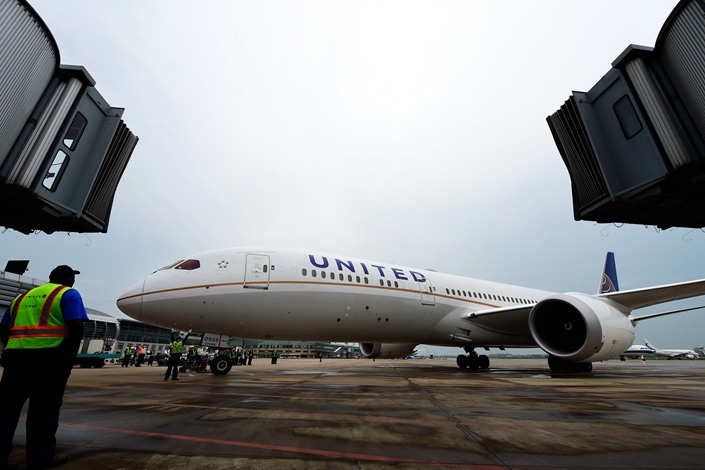China’s Aviation Rebound Remains Beyond the Horizon, Even as Subsidies Lift Domestic Market

Fresh analysis paints a grim picture of how China’s airline industry is faring amid the coronavirus outbreak — with at least one airline having to sell a few jets to maintain cash flow — though government handouts are helping to buoy some.
According to a report by the Center for Asia Pacific Aviation (CAPA) released Tuesday, capacity in the domestic market has recovered very slightly since bottoming out in mid-February, when it was down 71% year-on-year. Just 4.2 million seats were sold in the week commencing Feb. 17. That was expected to rise to over 10 million seats next week, which was 22% below 2019 levels. China’s international seat capacity was down 81% year-on-year last week and up a fraction of a percent this week.
The stabilization was driven by a series of government subsidies handed out by the Civil Aviation Administration of China to encourage carriers to restart flights, CAPA said. That included payments of 0.0176 yuan ($0.00251) per available seat kilometer for overseas routes operated by multiple carriers, and 0.0528 yuan for those operated by just one. An “available seat kilometer” is a measure of passenger-carrying capacity calculated by multiplying the number of seats on a flight by the number of kilometers traveled.
China has expanded direct services on homegrown carriers in recent years, with the city of Wuhan being a prime example. Wuhan, the city at the epicenter of the outbreak, had no direct international services in 2000, whereas before coronavirus struck it had 30 international routes to every continent except South America.
“A potential bright spot is that the Chinese airlines have filed more capacity for the Labor Day holidays in early May than in recent weeks,” the report said.
However there was a “pessimistic” outlook for Chinese outbound travel in March and June, with no signs of a recovery. The avalanche of event postponements and cancellations was a primary driver of decreased airline demand, and there was no sign this variable was likely to change.
Meanwhile inbound travel into China was a withering 5% to 8% what it was before the coronavirus crisis.
That Chinese airlines’ share prices have not been battered as much as their international peers reflects “investor hopes of potential state intervention,” the report said. “(They) are therefore not a true indicator of the underlying demand picture or outlook.”
It was still too early to say that the Chinese air travel market had stabilized, the report concluded.
“It may well be cheap fares within China, but it’s not sustainable,” said StrategicAero Research Chief Analyst Saj Ahmad. “Any recovery is a pseudo recovery frankly.”
The coronavirus and resulting government travel restrictions have seen airlines around the world nosedive into the red as flight cancelations erode airlines’ cash reserves and many fall into technical bankruptcy or default on debt.
While initially most travel bans focused on China, they have been expanded as major self-sustaining coronavirus outbreaks have emerged in around 15 nations including Italy, Iran, Germany, Spain, France and the U.S.
The analysis follows a report on Monday, also from CAPA, which predicted that without government intervention most airlines around the world would be bankrupt by the end of May.
“The real question is not so much whether support will be provided, but how many industries will want government assistance,” Ahmad said. “So how much can be pumped into the broader economies around the world without hiking inflation? Where would you draw the line? And who’s (going to) pay for it all if we’re all quarantined!”
Cathay in crisis
One airline in dire straits is Cathay Pacific, which said it lost more than HK$2 billion ($257 million) in February, with those losses expected to worsen in March (link in Chinese). Hong Kong’s largest airline had already run into turbulence last year, losing $434 million in the second half as months of protests in its home city kept tourists away.
The carrier transported 64% fewer passengers in February than for the same period last year. The airline’s regional routes to and from the Chinese mainland, Taiwan, South Korea and the Philippines saw the worst declines, with average daily passenger capacity falling below 20,000 by the end of February, down from 90,000 in the past.
Cathay Pacific customer and business president Lin Shaobo said long-haul routes had also been affected as various governments have rolled out travel bans, and demand was expected to decline further. The carrier plans to cut capacity by almost 90% in April, and do the same in May if travel restrictions remain in place.
Cathay has begun to sell aircraft assets to maintain cash flow. The company announced on Monday that it would sell six Boeing 777-300ER jets to BOC Aviation and signed a sale and leaseback agreement, for just over $703 million.
Bai Yujie and Wei Yiyang contributed reporting
Contact reporter Flynn Murphy (flynnmurphy@caixin.com) and editor Joshua Dummer (joshuadummer@caixin.com)

- MOST POPULAR




